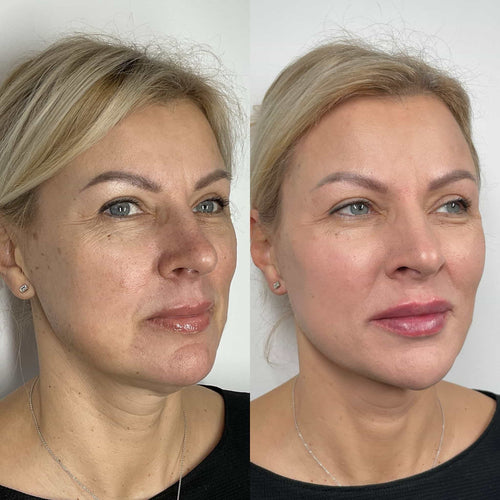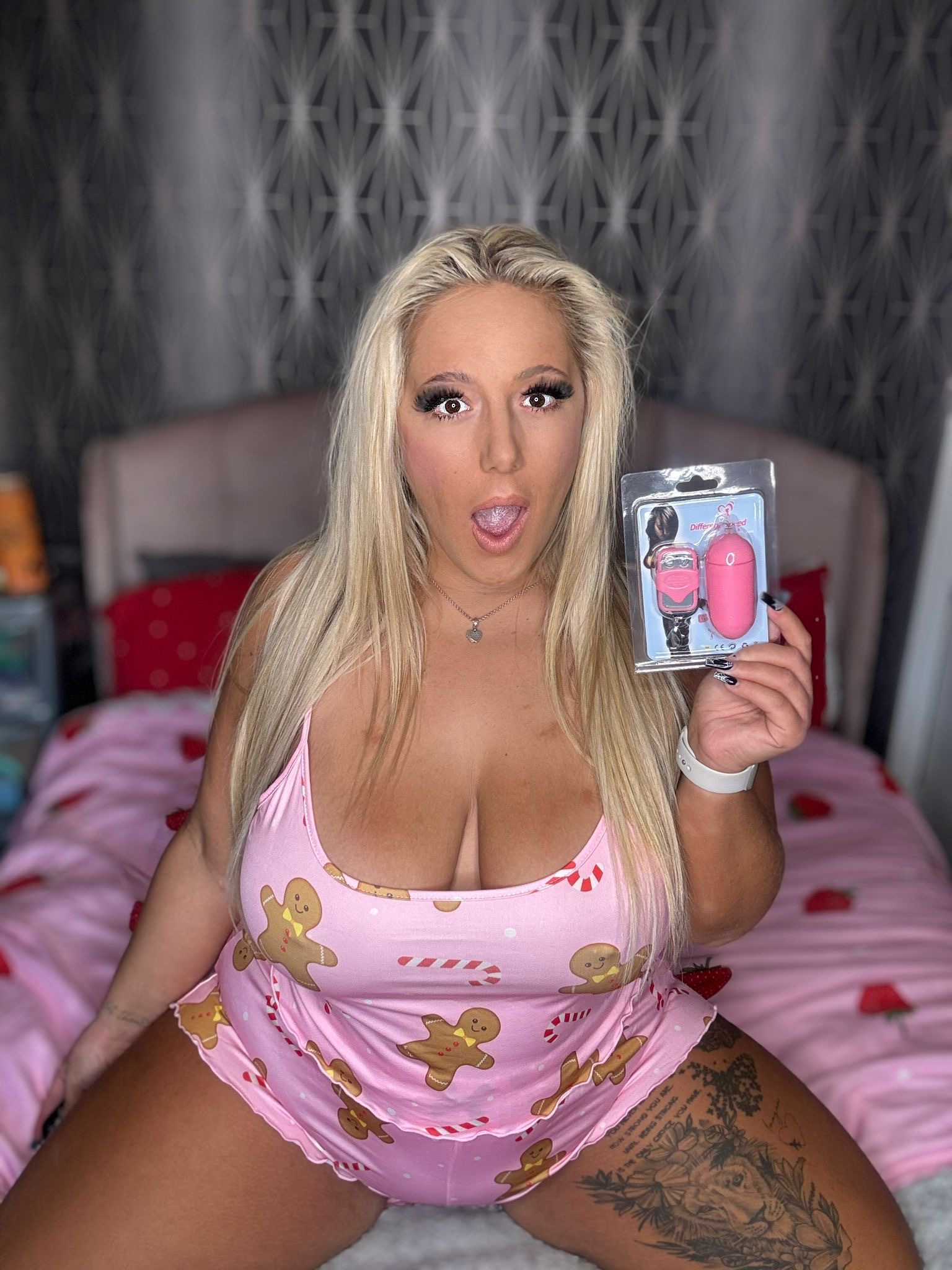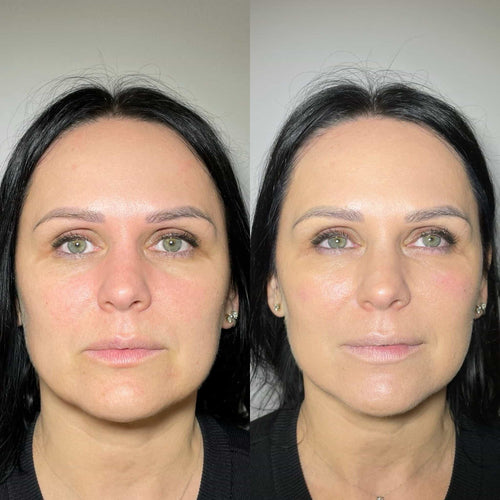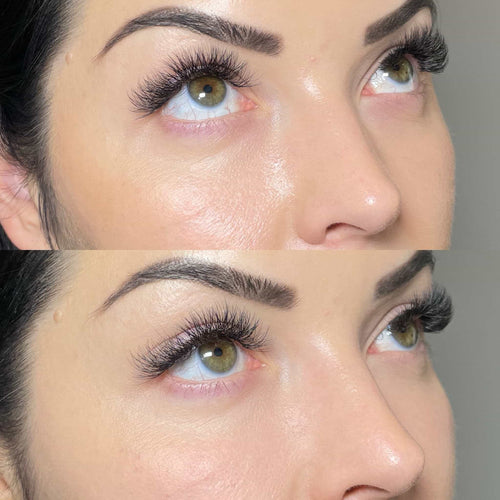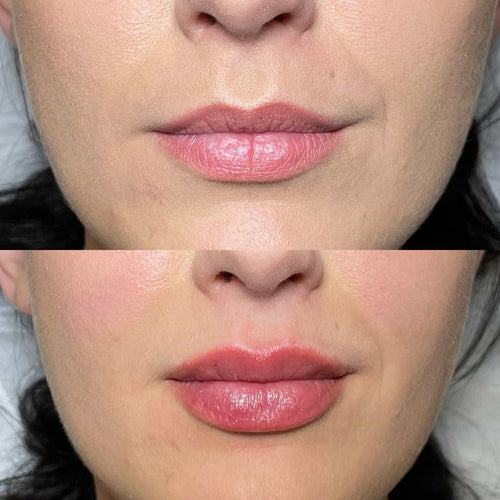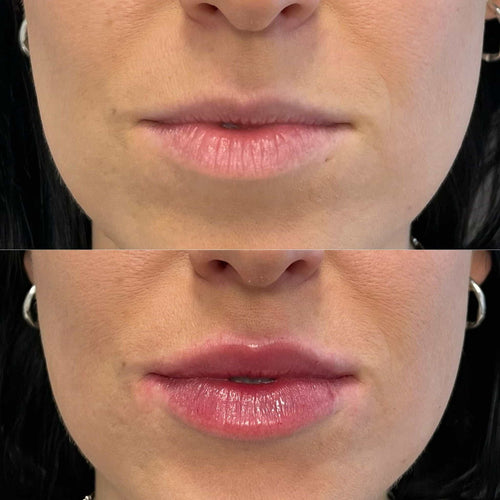Book a Dermal Filler Consultation at It’s Me and You Clinic with Dr. Laura Geige
Causes of Vertical Lines Around the Mouth
The formation of vertical lines around the mouth, also known as marionette lines or nasolabial folds, is a common concern for many people as they age. These fine lines are caused by a combination of factors, including muscle activity, loss of collagen and elastin, and skin laxity.
One of the primary causes of vertical lines around the mouth is the repeated action of the muscles that control facial expressions. When we frown or smile, these muscles contract and relax repeatedly, causing the skin to stretch and eventually develop wrinkles. The nasolabial folds are particularly susceptible to this type of muscle activity, as they connect the nose to the mouth.
Another major contributor to the development of vertical lines around the mouth is the loss of collagen and elastin, two essential proteins that give skin its strength and elasticity. As we age, the production of these proteins slows down, leading to a decrease in skin firmness and an increase in wrinkles. Collagen provides structural support to the skin, while elastin allows it to snap back into place after stretching.
Skin laxity is another key factor in the formation of vertical lines around the mouth. As we age, the skin’s ability to retain its natural moisture and firmness declines, causing it to sag and lose its elasticity. This can lead to a more pronounced appearance of wrinkles, including those around the mouth.
The skin structure itself also plays a significant role in the development of vertical lines around the mouth. The dermis, the layer of skin just beneath the epidermis, is richly supplied with blood vessels and contains fibroblasts, which are cells responsible for producing collagen and elastin. As we age, the number of fibroblasts declines, leading to a decrease in collagen and elastin production and a corresponding decline in skin firmness.
The lip lines, also known as perioral wrinkles, are another type of wrinkle that can occur around the mouth. These lines are caused by a combination of factors, including muscle activity, loss of collagen and elastin, and skin laxity. The lips themselves can also contribute to the formation of wrinkle lines around the mouth, particularly if they are thin or have a tendency to sag.
In addition to these internal factors, external ones such as sun exposure, smoking, and genetics can also contribute to the development of vertical lines around the mouth. Prolonged exposure to ultraviolet (UV) radiation from the sun can damage the skin’s collagen and elastin fibers, leading to an increase in wrinkle formation. Smoking, on the other hand, can cause blood vessels to constrict, reducing blood flow to the skin and contributing to a decrease in collagen production.
Genetics also play a significant role in the development of vertical lines around the mouth. Some people may be more prone to wrinkles due to their genetic makeup, which can affect the rate at which collagen and elastin are produced or how well they are maintained by the skin’s fibroblasts.
The combination of these internal and external factors can result in a range of different wrinkle lines around the mouth, from fine marionette lines to deeper, more pronounced perioral wrinkles. Understanding the causes of vertical lines around the mouth is an essential step in developing effective treatments and prevention strategies.
In order to address vertical lines around the mouth, it’s essential to consider a multi-faceted approach that targets both internal and external factors. This may include using topical creams or serums that contain ingredients such as retinol, vitamin C, or peptides, which can help to stimulate collagen production and improve skin firmness.
In addition to these treatments, there are several lifestyle changes that can be made to help reduce the appearance of vertical lines around the mouth. These include protecting the skin from the sun by using sunscreen and wearing protective clothing, quitting smoking, and maintaining a healthy diet that is rich in antioxidants and essential fatty acids.
Finally, there are a range of cosmetic treatments available that can help to address vertical lines around the mouth. These may include chemical peels, microdermabrasion, or injectable fillers such as hyaluronic acid or collagen. In some cases, surgical procedures such as a facelift or skin tightening surgery may be necessary to restore a more youthful appearance.
The appearance of vertical lines around the mouth, also known as nasolabial folds or marionette lines, can be a distressing concern for many individuals. These deepened wrinkles are caused by a combination of factors, primarily related to the loss of elastin and collagen in the skin.
Elastin is a protein that plays a crucial role in maintaining the skin’s elasticity and flexibility. As we age, elastin fibers begin to break down, leading to a loss of skin firmness and an increase in wrinkle depth. In the case of nasolabial folds, the loss of elastin allows the facial skin to sag and fold inward, creating deep grooves around the mouth.
Collagen is another essential protein that provides structure and support to the skin. As we age, collagen production slows down, leading to a decline in skin elasticity and firmness. In the nasolabial folds area, the loss of collagen allows the skin to lose its ability to snap back into place, resulting in deeper wrinkles.
Other factors can contribute to the formation of vertical lines around the mouth, including:
Smoking: Smoking damages elastin fibers and reduces blood flow to the skin, leading to premature aging. The chemicals present in cigarette smoke also break down collagen, further exacerbating wrinkle formation.
Aging: As we age, our skin’s natural ability to regenerate and repair itself declines. This leads to a cumulative effect of micro-damage over time, resulting in deepened wrinkles like nasolabial folds.
Lack of facial expression: In the past, smiling and other facial expressions were essential for communication and emotional well-being. As people became more reserved, their facial muscles lost their natural ability to move freely, leading to a decrease in elastin production and an increase in wrinkle formation.
Genetics: Genetic predisposition can play a significant role in the development of nasolabial folds. Individuals with a family history of premature aging or wrinkles may be more prone to developing deepened lines around the mouth.
Poor skincare habits: Failure to protect the skin from environmental stressors like UV radiation, pollution, and extreme temperatures can lead to accelerated wrinkle formation.
Lack of essential nutrients: Deficiencies in vitamins A, C, and E, as well as minerals like zinc and iron, can impair elastin production and collagen synthesis, contributing to premature aging.
Stress: Chronic stress can lead to increased cortisol levels, which break down collagen and elastin fibers, resulting in a decline in skin elasticity and firmness.
Medications: Certain medications, such as those used to treat depression, high blood pressure, and cancer, can cause dryness and thinning of the skin, leading to nasolabial folds.
Treatment options for vertical lines around the mouth are available, including:
Dermatological procedures: Chemical peels, microdermabrasion, and laser treatments can help stimulate collagen production and improve skin texture. Facelifts and other surgical procedures can also address nasolabial folds by tightening underlying facial tissues.
Topical treatments: Creams and serums containing retinoids, peptides, and hyaluronic acid can help stimulate elastin production and collagen synthesis, reducing wrinkle depth over time.
Lifestyle changes: Maintaining a healthy lifestyle through regular exercise, balanced nutrition, stress management, and adequate sleep can also contribute to improved skin health and reduced wrinkle formation.
The formation of vertical lines around the mouth, also known as *mouthlines*, is a common concern for many individuals. These deep lines can be unsightly and may affect one’s self-esteem.
There are several factors that contribute to the development of vertical lines around the mouth. One major cause is *_muscle activity_*, particularly the actions that involve smiling, frowning, or talking.
The facial muscles responsible for these movements contract repeatedly throughout a person’s lifetime, causing the skin to stretch and thin out. This repeated stress on the skin can lead to the breakdown of *_elastin fibers_*, which are essential for maintaining skin elasticity and firmness.
Book a Consultation for Dermal Fillers with Dr. Laura Geige at It’s Me and You Clinic
Another significant factor is *_facial expressions_*. Smiling, laughing, or showing anger can all cause the muscles around the mouth to contract, leading to wrinkles and fine lines. The more one smiles, frown, or talk, the greater the risk of developing vertical lines around the mouth.
Aging is also a significant contributor to the formation of vertical lines around the mouth. As we age, our skin loses its elasticity and firmness due to the natural aging process, which includes the breakdown of *_collagen fibers_* and *_elastin fibers_*. This loss of collagen and elastin can lead to sagging skin and wrinkles.
Genetics can also play a role in the formation of vertical lines around the mouth. Some people may be more prone to developing fine lines and wrinkles due to their genetic makeup.
Lifestyle factors such as *_smoking_* and *_sun exposure_* can also contribute to the development of vertical lines around the mouth. Smoking can lead to premature aging, while excessive sun exposure can cause damage to the skin, leading to wrinkle formation.
Furthermore, *lax facial muscles* can also contribute to the formation of vertical lines around the mouth. When the facial muscles are not properly toned and supported, they can sag, causing the skin to lose its natural shape and leading to wrinkles and fine lines.
Finally, *poor postural habits* or *_chronic stress_* can also cause tension in the face, particularly around the mouth area, leading to muscle strain and resulting vertical lines.
Understanding the causes of vertical lines around the mouth is essential for addressing this common concern. By recognizing these factors and making lifestyle changes, individuals can reduce their risk of developing these unsightly lines.
Causes of vertical lines around the mouth can be attributed to a combination of lifestyle, environmental, and medical factors. One of the primary causes is _Facial Muscle Fatigue_ , which can occur due to repetitive movements of facial muscles such as smiling, frowning, or scowling.
Another common cause of vertical lines around the mouth is Squinting, which can lead to the formation of Furrow Lines . When we squint, our facial muscles contract and relax repeatedly, causing tiny wrinkles to form between our eyebrows and around our mouths.
Furthermore, _Dry Skin_ can also contribute to the formation of vertical lines around the mouth. As we age, our skin becomes less hydrated due to decreased collagen production, leading to the development of fine lines and wrinkles.
Some medical conditions can also cause vertical lines around the mouth. For instance, _TMJ (Temporomandibular Joint) Disorder_ can lead to facial muscle strain, which can result in the formation of lines around the mouth. Similarly, Clinical Depression and other psychiatric conditions can cause facial muscles to tense up, resulting in the formation of vertical lines.
Medications such as *_Botox_* can also be a contributing factor to the development of vertical lines around the mouth. Botox is a popular cosmetic treatment that involves injecting botulinum toxin into facial muscles to temporarily relax them and reduce wrinkles. However, if not used correctly or in excessive amounts, it can lead to Paralysis of the facial muscles, resulting in the formation of vertical lines.
Aged skin is also a major contributor to the development of vertical lines around the mouth. As we age, our skin loses its elasticity and firmness, leading to the formation of fine lines and wrinkles.
Lack of Sun Protection can also cause vertical lines around the mouth. UV radiation from the sun can damage our skin’s collagen production, leading to premature aging and the formation of fine lines and wrinkles.
Smoking is another significant contributor to the development of vertical lines around the mouth. Cigarette smoke contains chemicals that can damage our skin’s collagen production, leading to premature aging and the formation of fine lines and wrinkles.
Genetics can also play a role in the development of vertical lines around the mouth. Some people may be more prone to developing facial wrinkles due to their genetic makeup.
To fix vertical lines around the mouth, it’s essential to address the underlying causes. This can involve Facial Exercises to strengthen facial muscles and reduce fatigue. Additionally, protecting your skin from the sun by using Sunscreen and wearing protective clothing can help prevent further damage.
In some cases, medical treatment may be necessary to address underlying conditions such as TMJ disorder or clinical depression. Your doctor can recommend Medical Treatment options such as pain management, therapy, or medication to address these conditions.
Facial fillers such as *_Hyaluronic Acid_* and *_Calcium Hydroxylapatite_* can also be used to fill in deep lines and wrinkles around the mouth. These treatments involve injecting a substance into the affected area to restore lost volume and smooth out the skin.
Ultimately, fixing vertical lines around the mouth requires a comprehensive approach that addresses both lifestyle and medical factors. By understanding the causes of these lines and taking steps to address them, you can reduce their appearance and achieve a smoother, more youthful complexion.
The presence of vertical lines or furrows around the mouth can be a worrying and frustrating symptom for many individuals, but it is often associated with a deeper underlying issue.
Acid reflux and gastroesophageal reflux disease (GERD) are two conditions that have been commonly linked to the development of vertical lines around the mouth. To understand how these conditions contribute to this symptom, it’s essential to delve into what causes them and how they affect the body.
Acid reflux occurs when stomach acid flows back up into the esophagus, often triggered by eating certain foods or drinks that can relax the lower esophageal sphincter (LES). The LES is a ring-like muscle that separates the esophagus and stomach, but if it becomes weakened, food and acid can pass through it more easily.
Gastroesophageal reflux disease (GERD) is a chronic condition characterized by recurring acid reflux. While not everyone who experiences acid reflux will develop GERD, persistent symptoms can lead to inflammation and damage in the esophagus, which may cause vertical lines around the mouth due to chronic irritation and scarring.
Other factors that contribute to the development of vertical lines around the mouth include aging, genetics, and lifestyle habits. As we age, our skin loses collagen and elastin, leading to sagging and wrinkling. Additionally, certain genetic predispositions can affect the structure of the face and contribute to the formation of fine lines and wrinkles.
Lifestyle factors such as smoking, excessive drinking, and poor eating habits can also play a significant role in the development of vertical lines around the mouth. Smoking, for instance, reduces blood flow and damages skin tissue, leading to premature aging. Consuming high-sugar diets and drinking too much acidic beverages like citrus juice or soda can further irritate the skin and exacerbate symptoms.
Furthermore, the way we sleep can also impact the appearance of vertical lines around the mouth. Sleeping with your mouth open or in an awkward position can cause strain on the facial muscles, leading to wrinkles and fine lines over time.
Medical conditions such as hypothyroidism, Sjögren’s syndrome, and Bell’s palsy can also lead to vertical lines around the mouth due to decreased saliva production, dry skin, or facial paralysis. Other systemic diseases like diabetes and rheumatoid arthritis may also cause skin thinning and increased sensitivity in the oral area.
However, it is essential to note that not all cases of vertical lines around the mouth are caused by these conditions. Sometimes, they can be a result of external factors such as sun exposure, wind, or even certain medications like statins or antidepressants.
Given the complex interplay between various factors contributing to vertical lines around the mouth, addressing the root cause of the issue is crucial for effective treatment and prevention.
A combination of lifestyle modifications, medical treatments, and in some cases, surgical interventions may be necessary to alleviate symptoms and improve appearance. A healthcare professional or dermatologist can help determine the underlying cause of the symptom and develop a personalized plan for addressing it.
A common concern for many individuals, vertical lines around the mouth can be a sign of an underlying condition. One of the primary causes of these lines is Chronic acid reflux, also known as gastroesophageal reflux disease (GERD). This condition occurs when stomach acid flows back up into the esophagus, causing inflammation and irritation in the throat and mouth.
The constant inflammation can lead to the formation of vertical lines or furrows around the mouth, particularly on the upper lip. These lines are known as perioral furrows, and they can be a sign that the body is experiencing chronic acid reflux symptoms.
Inflammation caused by acid reflux can also lead to changes in the shape of the mouth and lips, resulting in a more sunken appearance. This can make it difficult for individuals with this condition to wear certain types of clothing or perform everyday activities without feeling self-conscious about their appearance.
Other causes of vertical lines around the mouth include:
Smoking and tobacco use: Smoking can cause chronic inflammation in the mouth, leading to the formation of wrinkles and fine lines. The chemicals present in tobacco smoke can also irritate the skin and mucous membranes, contributing to the development of perioral furrows.
Cosmetic procedures: Certain cosmetic procedures, such as facial injections or surgery, can cause inflammation and lead to the formation of vertical lines around the mouth. These procedures should only be performed by a licensed professional using sterile equipment and following proper technique.
Genetic factors: Some individuals may be more prone to developing vertical lines around the mouth due to their genetic makeup. Family history can play a role in the development of this condition, particularly if a close relative has experienced perioral furrows or other oral health issues.
Dietary habits: A diet high in caffeine and citrus fruits can exacerbate acid reflux symptoms and lead to inflammation in the mouth. Reducing or eliminating these substances from your diet may help alleviate vertical lines around the mouth.
Hormonal changes: Hormonal fluctuations during pregnancy, menopause, or puberty can lead to changes in the mouth and lips, resulting in vertical lines. These hormonal changes can also contribute to the development of acid reflux symptoms.
It’s essential to address the underlying cause of vertical lines around the mouth, rather than just treating the symptom. By understanding the causes of this condition, individuals can take steps to prevent its progression and reduce the appearance of perioral furrows.
In the next section, we will discuss treatment options for addressing vertical lines around the mouth, including lifestyle changes, home remedies, and professional treatments.
The appearance of vertical lines or nasolabial folds around the mouth can be a concern for many individuals, particularly as they age. These deep-set wrinkles are formed by a combination of facial muscle contractions, loss of skin elasticity, and fat pad atrophy.
One of the primary causes of vertical lines around the mouth is the repeated contraction of the zygomaticus major muscle, which runs from the cheekbone to the corner of the mouth. When this muscle contracts, it creates a crease in the skin that can become more pronounced over time, leading to the formation of nasolabial folds.
Another factor contributing to the development of vertical lines around the mouth is the loss of fat pads in the facial area. As we age, the fat pads that once filled out the cheeks and lips begin to atrophy, causing the skin to sag and wrinkle more deeply.
Genetics also play a role in the formation of vertical lines around the mouth. Some individuals may be more prone to developing nasolabial folds due to their genetic makeup, which can affect the elasticity and firmness of their skin.
In addition, facial expressions that involve smiling, laughing, or raising an eyebrow can contribute to the formation of vertical lines around the mouth. These repeated contractions of the facial muscles can cause the skin to become thinner and more prone to wrinkling.
The use of tobacco products, such as cigarettes, can also accelerate the formation of vertical lines around the mouth. The chemicals in these products cause inflammation and damage to the skin, leading to the breakdown of collagen and elastin fibers and resulting in deeper wrinkles.
Furthermore, sun exposure and environmental stressors, such as pollution and UV radiation, can contribute to the formation of vertical lines around the mouth. These external factors can cause oxidative stress and damage to the skin, leading to the breakdown of collagen and elastin fibers.
The good news is that there are several treatment options available for addressing vertical lines around the mouth. Botox injections, which involve the administration of botulinum toxin A into the affected muscle, can help relax the zygomaticus major muscle and reduce the appearance of nasolabial folds.
Another popular option for treating vertical lines around the mouth is dermal fillers, such as hyaluronic acid or calcium hydroxylapatite. These fillers can be injected into the affected area to restore lost volume and smooth out wrinkles.
Surgical options, such as a facelift or eyelid surgery, may also be considered in more severe cases of vertical lines around the mouth. However, these procedures should only be undertaken by experienced professionals and carry significant risks and downtime.
Preventative measures can also help to reduce the appearance of vertical lines around the mouth. Protecting the skin from sun damage through the use of sunscreen and avoiding tobacco products can help to slow down the aging process.
A healthy lifestyle, including a balanced diet and regular exercise, can also help to promote skin health and reduce wrinkles. By making informed choices about facial care and addressing underlying causes, individuals can take steps to minimize the appearance of vertical lines around the mouth.
The appearance of vertical lines around the mouth can be a distressing sign of aging, particularly for individuals who have lost facial volume and muscle mass. These lines, also known as nasolabial folds or mouth lines, are caused by a combination of factors that lead to the loss of skin elasticity and firmness, as well as the atrophy of muscles in the face.
One primary cause of vertical lines around the mouth is facial sagging, which can occur due to a lack of collagen production, fat depletion, or muscle weakness. As we age, our bodies naturally produce less collagen, a key protein that gives structure and strength to skin. Without sufficient collagen, the skin becomes thinner, more fragile, and loses its ability to maintain its natural firmness.
Another significant contributor to vertical lines around the mouth is muscle imbalances, particularly in the orbicularis oris muscle, which surrounds the mouth. As we age, this muscle can become weaker, causing the lips and mouth to droop, creating a deeper groove that can accentuate the appearance of fine lines.
Facial expressions, especially those that involve smiling, laughing, or frowning, can also contribute to the formation of vertical lines around the mouth. Repeated contractions of facial muscles can lead to the development of wrinkles and fine lines over time, particularly in areas such as the nasolabial fold.
Botox injections have become increasingly popular for treating facial wrinkles, including those around the mouth. Botox works by temporarily paralyzing muscle fibers that contribute to wrinkle formation. By injecting Botox into specific muscles, such as the orbicularis oris, individuals can experience a reduction in fine lines and wrinkles, creating a smoother appearance.
Facial fillers have also emerged as effective treatments for addressing vertical lines around the mouth. Fillers, such as hyaluronic acid, calcium hydroxylapatite, or poly-L-lactic acid, are injected into the affected areas to restore lost volume and smooth out wrinkles. By filling in the nasolabial fold, fillers can help to reduce the appearance of fine lines and create a more youthful look.
Other treatment options for vertical lines around the mouth include dermal fillers that contain a combination of hyaluronic acid and calcium hydroxylapatite, as well as surgical facelifts or fat transfer procedures. These treatments can provide more significant results but may come with higher risks and recovery times.
Preventing vertical lines around the mouth requires a comprehensive approach to skin care and facial health. Maintaining a healthy lifestyle through regular exercise, proper nutrition, and adequate sleep can help promote collagen production and skin elasticity. Additionally, avoiding excessive sun exposure and protecting the face from UV radiation can reduce the appearance of fine lines and wrinkles over time.
A well-structured skincare routine that includes gentle exfoliation, moisturizing, and antioxidant-rich products can also contribute to a more radiant and youthful complexion. Furthermore, practicing facial exercises can help strengthen facial muscles and improve overall skin tone.
Cause and Prevention:
Vertical lines around the mouth, also known as marionette lines, are a common sign of aging. They are caused by the repeated contractions of facial muscles, particularly the depressor anguli oris, which is responsible for frowning and smiling. These muscles can weaken with age, causing the skin to sag and form deep lines.
Other factors that contribute to the formation of vertical lines around the mouth include:
- Cigarette smoking: Nicotine in cigarettes can reduce blood flow to the facial muscles, leading to a decrease in collagen production and an increase in wrinkle depth.
- Squinting or frowning: Constantly scrunching up your face can cause the skin around your mouth to tighten, creating deep lines and wrinkles.
- Genetics: Some people may be more prone to developing vertical lines due to their genetic makeup.
- Lack of facial exercise: Not exercising the facial muscles can lead to weakness and sagging, contributing to the formation of fine lines.
Treatment Options:
For those who wish to avoid surgery or other invasive procedures, there are several non-invasive treatment options available. Botox injections can relax facial muscles that contribute to the formation of vertical lines around the mouth, providing a temporary solution. Botox works by blocking nerve signals that cause muscle contractions, resulting in a smooth and relaxed appearance.
Facial fillers, such as hyaluronic acid, can be used to plump up areas where fine lines are more prominent. These fillers are made from natural materials found in the body and can be injected directly into the skin to provide immediate results.
Botox Injections:
Botox is a popular treatment option for vertical lines around the mouth because of its ease of administration and relatively short duration of action. The effects of Botox typically last between 3-6 months, depending on individual factors such as muscle tone and skin type.
The process of getting Botox injections involves:
- Consulting with a qualified healthcare professional or dermatologist to determine the best treatment plan
- Receiving local anesthesia to minimize discomfort
- Painlessly injecting Botox into the affected areas using a fine needle
- Carefully massaging the treated area to ensure optimal absorption and distribution of the medication.
Facial Fillers:
Facial fillers offer a non-surgical alternative for those who want to address vertical lines around the mouth. Hyaluronic acid, also known as Juvederm or Restylane, is one type of facial filler commonly used for this purpose.
The process of getting facial fillers involves:
- Consulting with a qualified healthcare professional or dermatologist to determine the best treatment plan
- Scheduling a consultation and initial examination to assess skin texture and fat volume
- Receiving local anesthesia to minimize discomfort
- Injecting facial fillers into the affected areas using a fine needle.
Long-Term Prevention:
To prevent further formation of vertical lines around the mouth, it’s essential to maintain good skincare habits and incorporate regular facial exercises into your daily routine. This includes:
- Caring for your skin: Keeping your skin moisturized and protected from environmental stressors can help reduce fine line depth.
- Facial exercise: Engage in gentle facial exercises, such as smiling, frowning, and raising your eyebrows to keep the muscles flexible and toned.
- Protecting against smoking: Quitting or reducing cigarette smoking can slow down wrinkle formation and prevent further damage.
The appearance of vertical lines around the mouth, also known as marionette lines or nasolabial folds, can be caused by a combination of factors. One of the main causes is the loss of fat and collagen in the facial skin, particularly around the mouth area.
A decline in facial elasticity and firmness due to aging, genetics, or environmental factors can contribute to the formation of vertical lines around the mouth. This is because the facial muscles, including the orbicularis oris muscle, contract with each smile, laugh, or expression, causing wrinkles to form over time.
Another cause is sun exposure and UV radiation, which can damage the skin’s collagen and elastin fibers, leading to premature aging and wrinkle formation. Smoking also contributes to the development of vertical lines around the mouth, as it reduces blood flow to the face and causes inflammation that can lead to wrinkles.
Facial expressions, such as smiling, laughing, or frowning, can also contribute to the formation of vertical lines around the mouth. Repeated contractions of the facial muscles can lead to creasing and wrinkling over time.
Gravitational forces can also play a role in the formation of vertical lines around the mouth. As we age, our skin loses its elasticity and firmness, causing it to sag and droop, particularly around the mouth area.
Other medical conditions, such as Bell’s palsy or facial paralysis, can cause uneven facial expressions and lead to the formation of vertical lines around the mouth.
Additionally, poor posture, facial asymmetry, or congenital defects can also contribute to the appearance of vertical lines around the mouth.
Fortunately, there are several alternative therapies that can help reduce the appearance of vertical lines around the mouth without surgery. One option is chemical peels, which use alpha-hydroxy acids (AHAs) or beta-hydroxy acids (BHAs) to exfoliate the skin and promote collagen production.
Microdermabrasion is another non-invasive therapy that uses fine crystals to gently exfoliate the skin, removing dead skin cells and promoting cell turnover. This can help reduce the appearance of vertical lines around the mouth by improving skin texture and tone.
Botulinum toxin injections, also known as Botox, can be used to temporarily relax facial muscles and reduce wrinkle formation around the mouth. While this is not a long-term solution, it can provide quick results and help alleviate concerns about vertical lines.
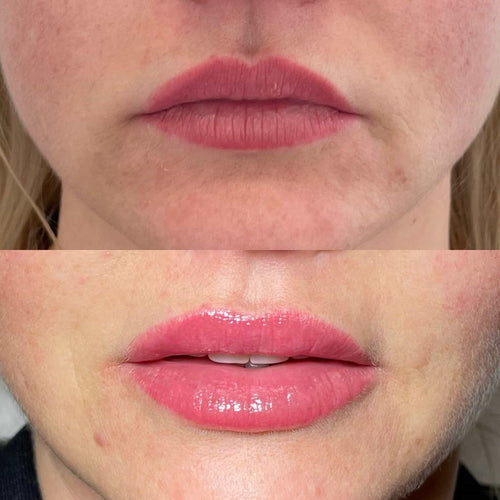
Schedule Your Dermal Filler Session with Dr. Laura Geige
Facial massage therapy has been shown to improve blood flow and promote collagen production, which can help reduce the appearance of wrinkles and fine lines, including vertical lines around the mouth.
Laser skin resurfacing is another alternative therapy that uses high-energy light to stimulate collagen production and improve skin texture. This can be an effective treatment for reducing vertical lines around the mouth, particularly when combined with other therapies such as chemical peels or microdermabrasion.
A diet rich in antioxidants, vitamins, and minerals, including vitamin C, vitamin E, and omega-3 fatty acids, can help promote collagen production and improve skin texture, reducing the appearance of vertical lines around the mouth. Staying hydrated by drinking plenty of water is also essential for maintaining healthy, plump skin.
Regular exercise and stress management techniques, such as meditation or yoga, can also help reduce wrinkles and fine lines, including vertical lines around the mouth, by promoting overall facial relaxation and well-being.
Topical creams and serums containing ingredients such as retinol, peptides, or hyaluronic acid can be used to promote collagen production, improve skin texture, and reduce wrinkle formation. While these treatments may not completely eliminate vertical lines around the mouth, they can help improve their appearance.
Platelet-rich plasma (PRP) therapy involves injecting platelet-rich plasma into the affected areas to stimulate collagen production and improve skin texture. This treatment has shown promise in reducing wrinkles and fine lines, including vertical lines around the mouth.
A holistic approach to skincare and wellness that incorporates natural ingredients, facial yoga, and stress management techniques can help promote overall facial health and reduce the appearance of vertical lines around the mouth.
The appearance of vertical lines or marionette lines around the mouth can be caused by a variety of factors, including aging, facial muscle contractions, and repeated movements such as smiling or laughing. As we age, our skin loses collagen and elastin, leading to the formation of wrinkles and fine lines, which can appear as vertical lines around the mouth.
Another common cause of vertical lines is the use of Botox injections in the facial muscles that surround the mouth. While Botox is commonly used to treat frown lines and forehead wrinkles, it can also relax the muscles in the lower face, causing the skin to sag and form vertical lines around the mouth.
Repeated expressions such as smiling or laughing can also cause vertical lines around the mouth. When we smile, our facial muscles contract and relax rapidly, which can lead to the formation of fine lines and wrinkles that appear as vertical lines around the mouth.
Another factor that contributes to the appearance of vertical lines is gravity. As we age, our skin loses its elasticity and firmness, causing it to sag and form wrinkles, including vertical lines around the mouth.
Cosmetic treatments such as chemical peels and microdermabrasion can help to reduce the appearance of vertical lines by improving skin texture and tone. Chemical peels involve applying a solution to the skin that removes the top layers of skin, revealing smoother, brighter skin.
Microdermabrasion is a non-invasive exfoliating treatment that uses fine crystals to remove dead skin cells, smooth out wrinkles, and improve skin texture and tone. It can help to reduce the appearance of vertical lines around the mouth by promoting cell turnover and collagen production.
Chemical peels work by penetrating deeper into the skin than microdermabrasion, which makes them more effective for treating deeper wrinkles and fine lines. The solution used in a chemical peel can vary depending on the individual’s skin type and concerns, but common ingredients include glycolic acid, lactic acid, and salicylic acid.
Microdermabrasion is generally less invasive than a chemical peel and requires fewer sessions to achieve results. It is also a more affordable option, as it does not require the use of a solution or topical creams.
A combination of both chemical peels and microdermabrasion can be an effective way to reduce the appearance of vertical lines around the mouth. Chemical peels can help to break down deep wrinkles and fine lines, while microdermabrasion can help to smooth out skin texture and tone.
It’s also worth noting that lifestyle changes such as quitting smoking, reducing sun exposure, and using sunscreen can help to prevent further damage to the skin and reduce the appearance of vertical lines around the mouth.
Facial exercises such as smiling with the corners of your mouth turned down, or making a “fish face” can also help to relax the muscles that cause vertical lines and improve skin elasticity. However, it’s essential to approach facial exercises with caution, as over-exertion can exacerbate the problem.
Cause of Vertical Lines Around the Mouth
Vertical lines, also known as nasolabial folds, are a common sign of aging. These lines occur when there is loss of facial fat and skin elasticity, causing the skin on the face to sag. This type of line typically starts at the sides of the mouth and runs upwards towards the nose, giving it a sad or drawn appearance.
Some causes of vertical lines around the mouth include:
-
Smiling and laughing repeatedly, which can cause repeated wrinkles and creases in the skin.
-
Aging, as facial fat loss and skin elasticity decrease with age.
-
Genetics, some people may be more prone to developing nasolabial folds due to their genetic makeup.
-
Smoking, which can cause premature aging of the skin by reducing blood flow and increasing wrinkles.
Causes of Vertical Lines Around the Mouth (continued)
In addition to these causes, there are some underlying health conditions that may contribute to the formation of vertical lines around the mouth. These include:
-
Gravitational changes, such as those experienced during pregnancy or menopause, which can cause weight gain and facial fat redistribution.
-
Certain medical conditions, such as hypothyroidism, can also contribute to the formation of nasolabial folds.
Cheemical Peels and Microdermabrasion: Non-Invasive Treatments for Vertical Lines Around the Mouth
Chemical peels and microdermabrasion are two popular non-invasive treatments that can help improve skin texture, reduce the appearance of wrinkles, including vertical lines around the mouth.
Cheemical Peels
A chemical peel is a solution applied to the skin to remove the top layers and smooth out fine lines and wrinkles. There are three main types of chemical peels:
-
Light peel: Suitable for sensitive skin, this type of peel removes only the outermost layer of the skin.
-
Medium peel: This type of peel is more aggressive and removes a larger layer of skin.
-
Dark peel: The most aggressive option, removing multiple layers of skin.
Microdermabrasion is often used as an alternative to chemical peels. It involves spraying fine crystals onto the skin to exfoliate and remove dead skin cells.
A series of microdermabrasion treatments can help:
-
Improve skin texture and tone
-
Reduce the appearance of fine lines and wrinkles
-
Minimize pores
Cheemical Peels (continued)
A series of chemical peels can help:
-
Improve skin texture and tone
-
Reduce the appearance of fine lines and wrinkles, including nasolabial folds
-
Minimize pores
Combination Treatment: Chemical Peels and Microdermabrasion for Vertical Lines Around the Mouth
A combination treatment using both chemical peels and microdermabrasion can provide more effective results than either treatment alone. This is because they target different layers of the skin, providing a comprehensive approach to addressing nasolabial folds.
Read more about Fringe Beverly Hills here. Read more about Humboldt Apothecary CBD here. Read more about Otherwheres Magazine here. Read more about Decléor Direct here. Read more about I Like Corbyn But here.






